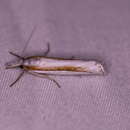Conservation Status
provided by University of Alberta Museums
Rather uncommon but of no concern.
- license
- cc-by-nc
- copyright
- University of Alberta Museums
Cyclicity
provided by University of Alberta Museums
June and July.
- license
- cc-by-nc
- copyright
- University of Alberta Museums
Distribution
provided by University of Alberta Museums
A North American species. Fernald (1896) mentions it from Ontario, Maine, New Hampshire, Massachusetts, New York, Pennsylvania, Maryland and Ohio. In addition, Handfield has it from Quebec and Labrador (1997), and Scholtens (1996) from Michigan. In Alberta, it occurs in the prairies and aspen parkland (Bowman (1951).
- license
- cc-by-nc
- copyright
- University of Alberta Museums
General Description
provided by University of Alberta Museums
A medium sized Crambus (25-28 mm wingspan). The forewings are silvery white with a longitudinal orange discal stripe; the narrow terminal line is brown with five dark brown dashes in the lower part. The hindwings are white and often smoky away from the margin. Probably the easiest recognized of any of the species. Crambus perlellus is also silvery white but lacks the orange stripe.
- license
- cc-by-nc
- copyright
- University of Alberta Museums
Habitat
provided by University of Alberta Museums
Prairie, aspen parkland and conifer forest.
- license
- cc-by-nc
- copyright
- University of Alberta Museums
Life Cycle
provided by University of Alberta Museums
Diurnal and comes to light. The egg and early stages have been described by Felt (1894).
- license
- cc-by-nc
- copyright
- University of Alberta Museums
Trophic Strategy
provided by University of Alberta Museums
No local information. Fernald (1896) says "grass roots".
- license
- cc-by-nc
- copyright
- University of Alberta Museums
Crambus girardellus: Brief Summary
provided by wikipedia EN
Crambus girardellus, or Girard's grass-veneer moth, is a moth in the family Crambidae described by James Brackenridge Clemens in 1860. It is found in North America, including Alberta, Ontario, Quebec, Labrador, Maine, New Hampshire, Massachusetts, New York, Pennsylvania, Maryland, Ohio and Michigan.
The wingspan is 25–28 mm. The forewings are silvery white with a longitudinal orange discal stripe and a narrow brown terminal line. The hindwings are white. Adults are on wing in June and July.
The larvae feed on the roots of grass species.
- license
- cc-by-sa-3.0
- copyright
- Wikipedia authors and editors

